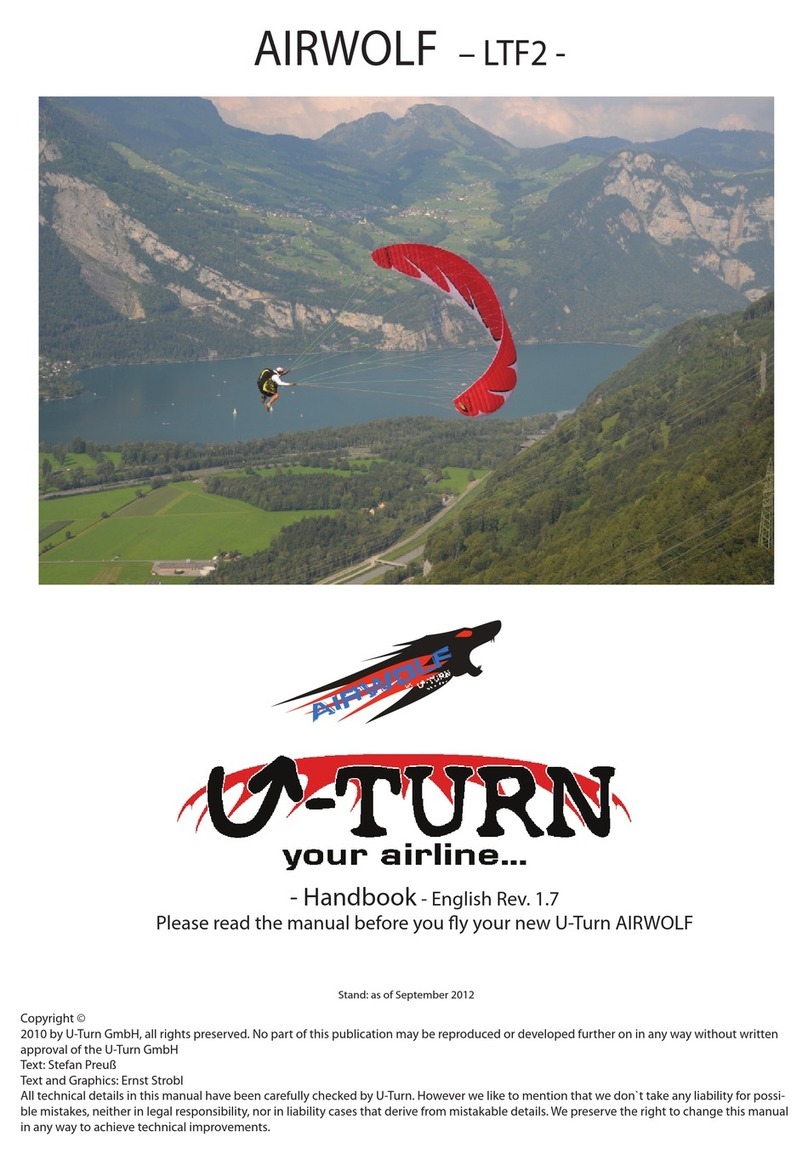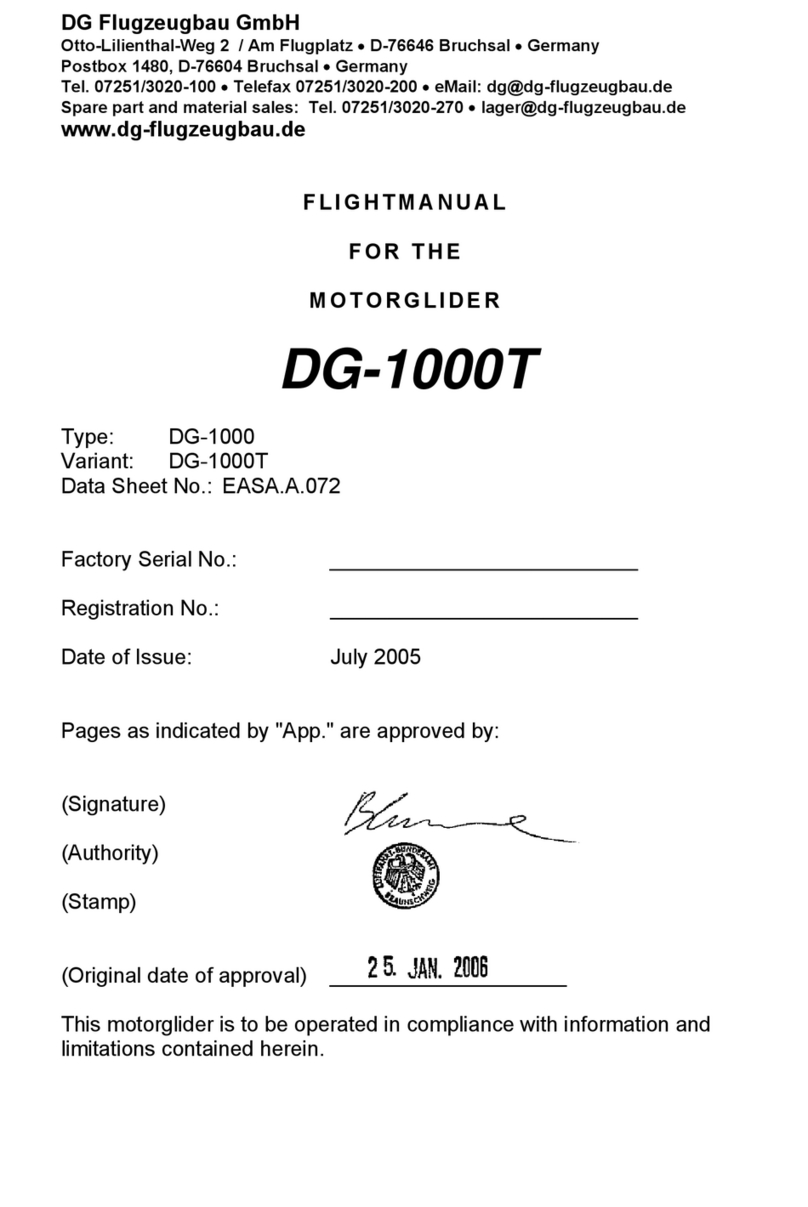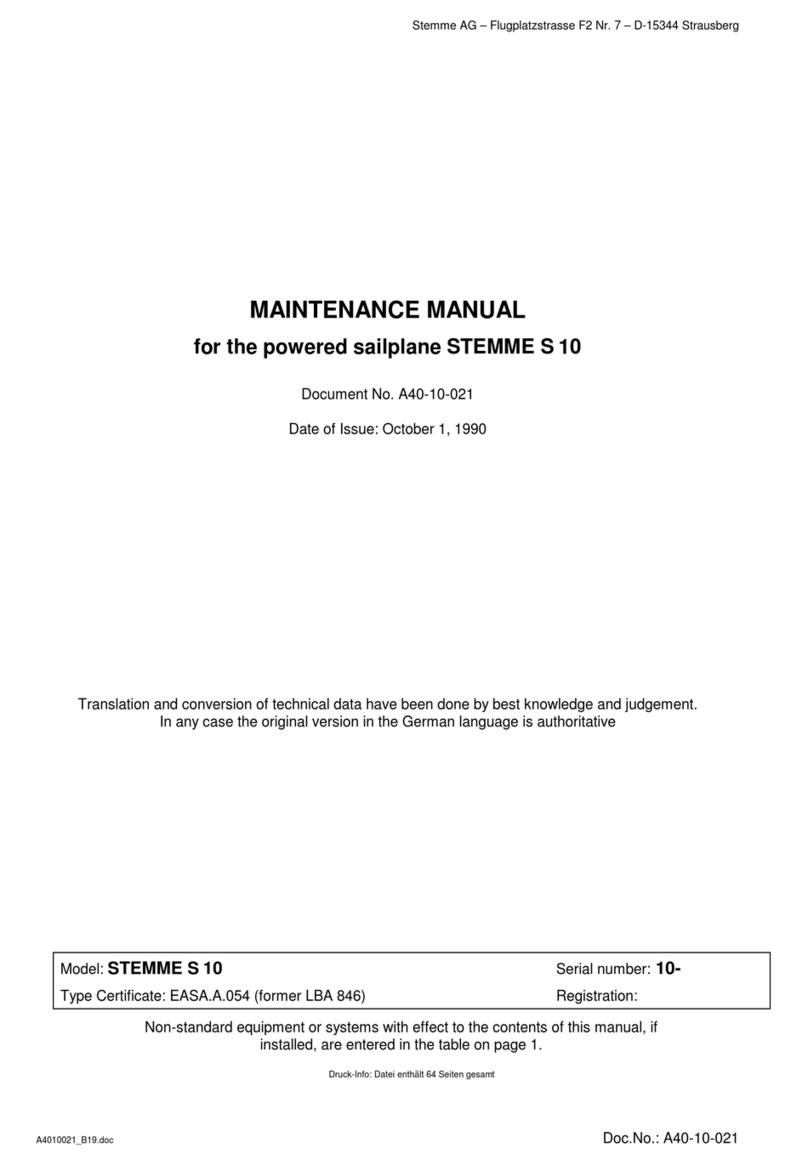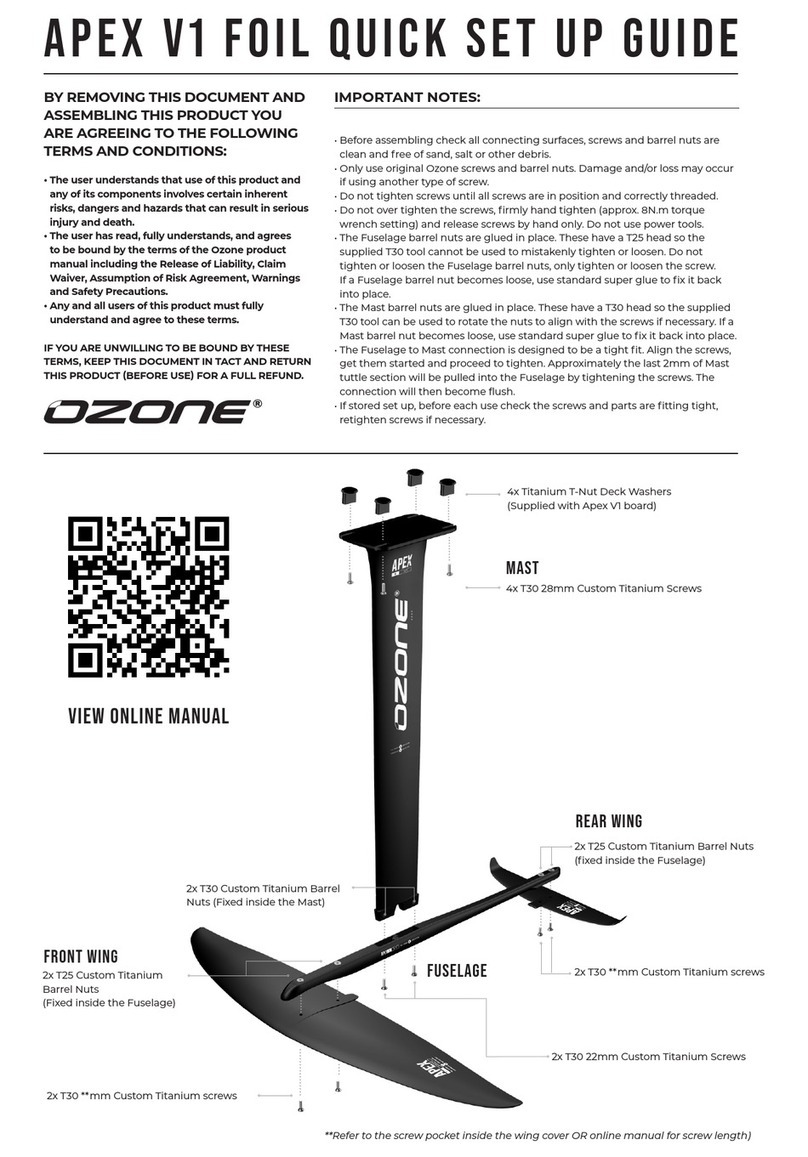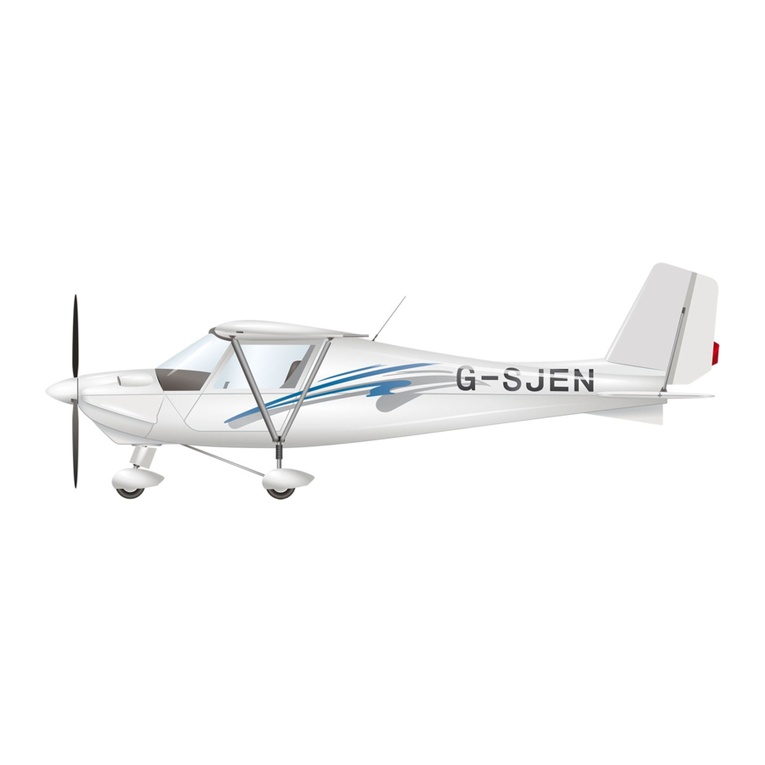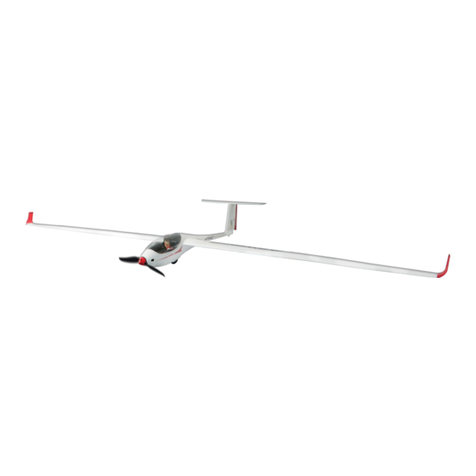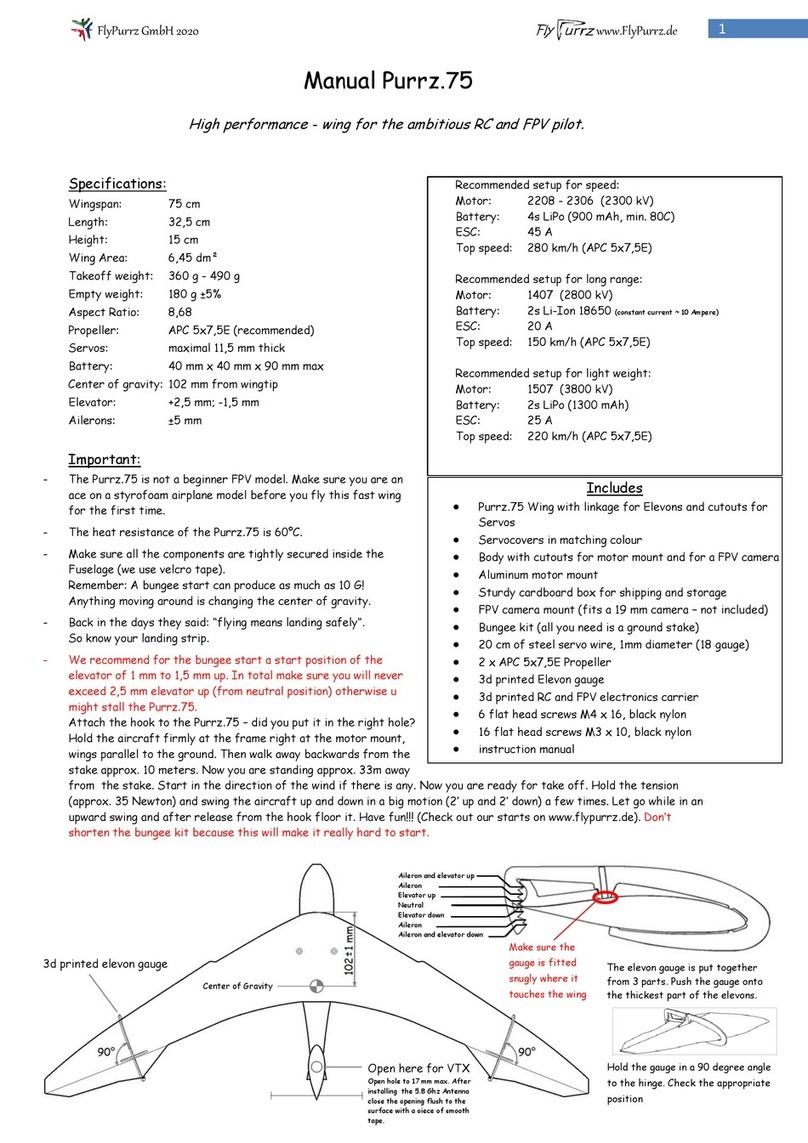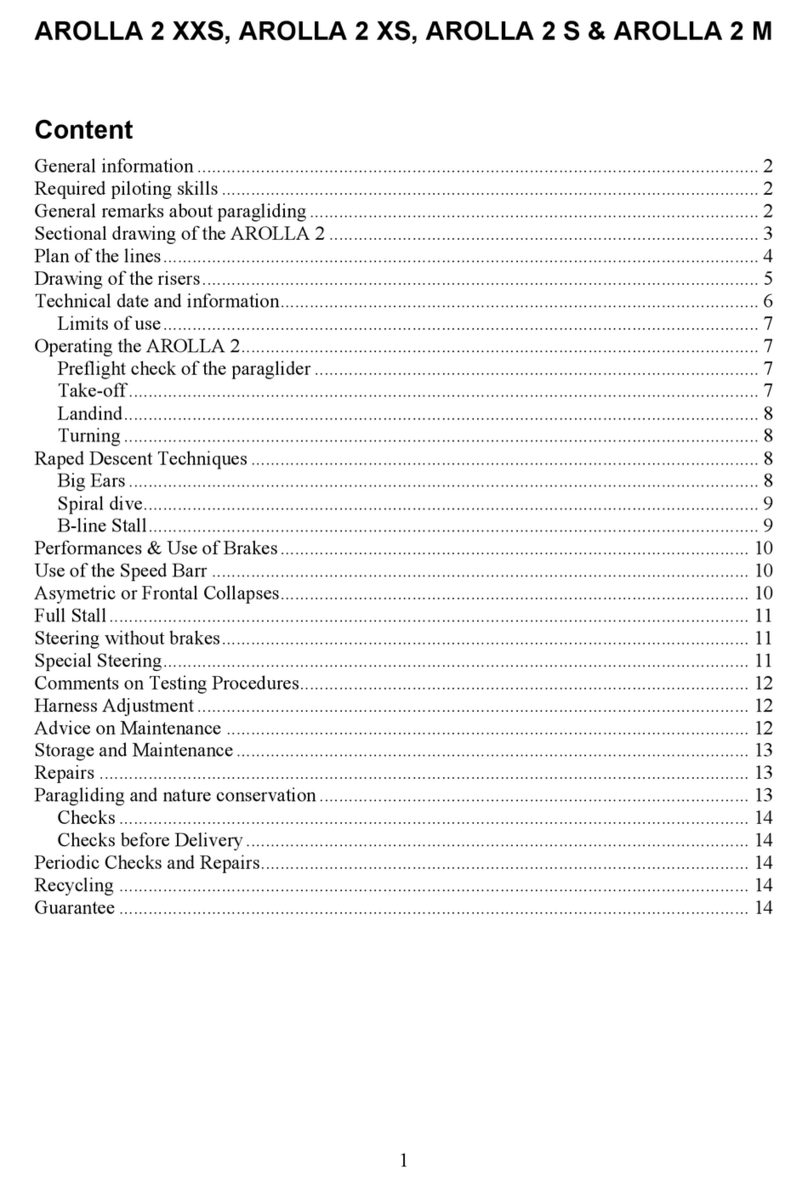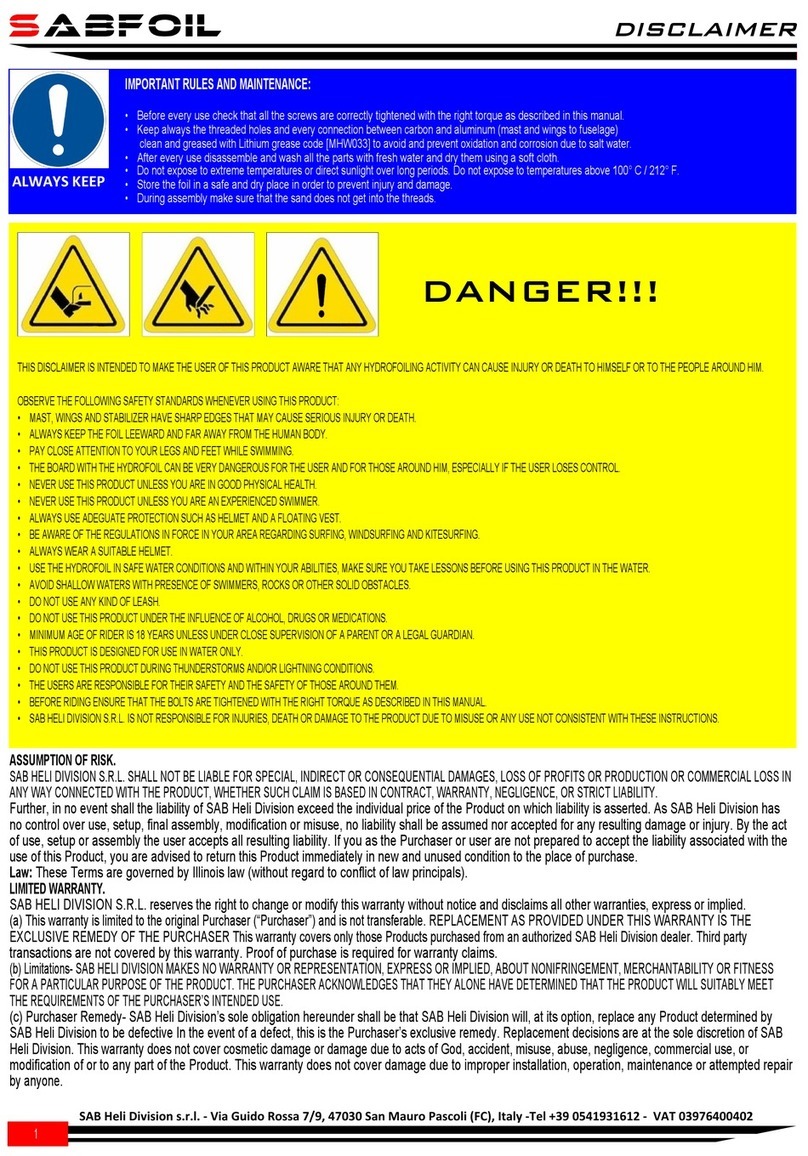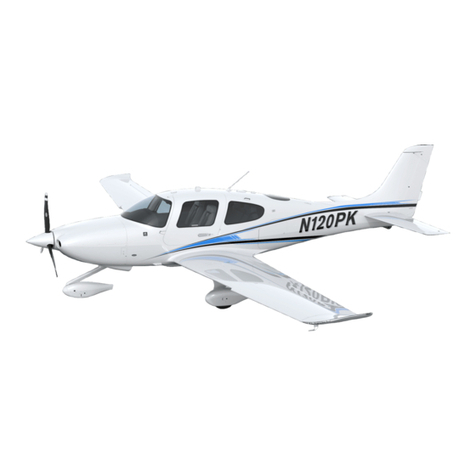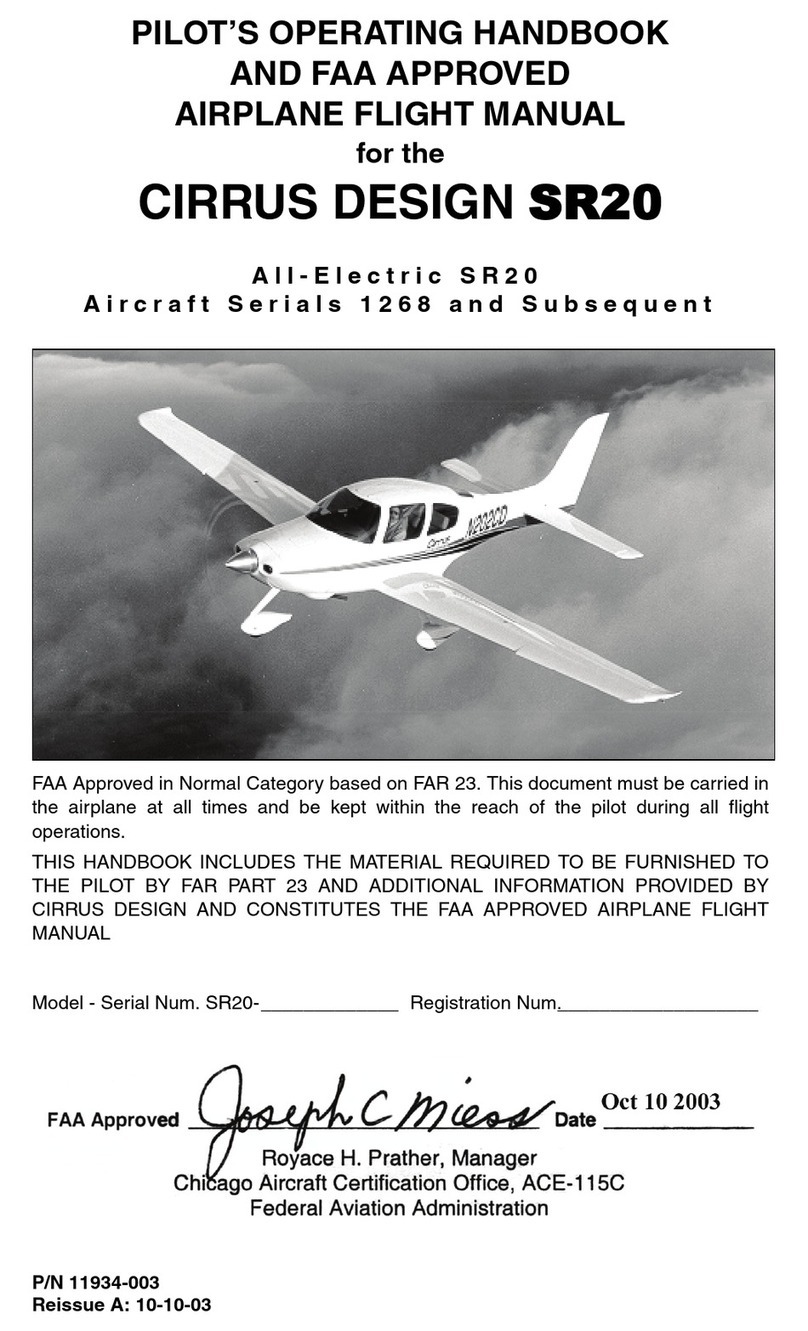Heli-Max Novus 200 FP User manual

Entire Contents © 2011 Hobbico®
, Inc. HMXE0809
(with supplied flight battery)
Length:
Width:
Height:
Rotor Span:
Weight:
16.54 in
3.54 in
5.9 in
[420mm]
[90 mm]
[150 mm]
[388mm]
[165g]
15.28 in
5.82 oz.
Specifications
Novus 200 FP 2.4GHz RTF
Instruction Manual
®
™

2
®
IMPORTANT PRECAUTIONS
IMPORTANT PRECAUTIONS
●Only use the included charger with the included battery or replacement
part (GPMP0411).
●Do not attempt to use this charger with NiCd or NiMH battery packs.
●Never charge in excess of 4.20V per cell.
●If the battery should become damaged, discard it. Do not attempt to use
a damaged battery.
●Do not leave the charger unattended while charging. Disconnect the
battery and remove input power from the charger immediately if either
becomes hot! However, it is normal for the charger to get warm.
●Disconnect the battery from the charger and carefully move the battery
to a fireproof location if the battery begins to swell or smoke!
●Never charge at currents greater than 1C.
●Always charge in a fireproof location.
●Never trickle charge.
●Never allow the battery temperature to exceed 150° F [65° C].
●Never disassemble or modify pack wiring in any way or puncture cells.
●Never discharge below 2.75V per cell.
●Do not allow water, moisture or foreign objects into the charger.
●Do not block the air intake holes, which could cause the charger to
overheat.
●Do not place the charger or any battery on a flammable surface or near
a combustible material while in use.
●Do not charge on a carpet, cluttered workbench, paper, plastic, vinyl,
leather, wood, or inside an R/C model.
●Never charge inside a full-sized vehicle.
●Always disconnect the battery from the charger and the power supply
from the charger when not in use.
●Do not attempt to charge a battery if it is swollen or hot.
●ALWAYS KEEP OUT OF REACH OF CHILDREN.

3
®
WARRANTY
WARRANTY
Heli-Max®guarantees this kit to be free from defects in both material and
workmanship at the date of purchase. This warranty does not cover any
component parts damaged by use or modification. In no case shall Heli-Max’s
liability exceed the original cost of the purchased kit. Further, Heli-Max
reserves the right to change or modify this warranty without notice.
In that Heli-Max has no control over the final assembly or material used for final
assembly, no liability shall be assumed nor accepted for any damage resulting
from the use by the user of the final user-assembled product. By the act of
using the user-assembled product, the user accepts all resulting liability.
If the buyer is not prepared to accept the liability associated with the use
of this product, the buyer is advised to return this kit immediately in new
and unused condition to the place of purchase.
To make a warranty claim, send the defective part or item to Hobby Services at
this address.
Hobby Services
3002 N. Apollo Dr., Suite 1
Champaign, IL 61822
USA
Include a letter stating your name, return shipping address, as much contact
information as possible (daytime telephone number, fax number, e-mail
address), a detailed description of the problem and a photocopy of the purchase
receipt. Upon receipt of the package the problem will be evaluated as quickly
as possible.
READ THROUGH THIS MANUAL BEFORE STARTING CONSTRUCTION. IT
CONTAINS IMPORTANT INSTRUCTIONS AND WARNINGS CONCERNING
THE ASSEMBLY AND USE OF THIS MODEL.

4
®
TABLE OF CONTENTS
TABLE OF CONTENTS
IMPORTANT PRECAUTIONS . . . . . . . . . . . . . . . . . . . . . . . . . . . . . . . . . . . . 2
WARRANTY. . . . . . . . . . . . . . . . . . . . . . . . . . . . . . . . . . . . . . . . . . . . . . . . . . 3
INTRODUCTION . . . . . . . . . . . . . . . . . . . . . . . . . . . . . . . . . . . . . . . . . . . . . . 5
SAFETY PRECAUTIONS. . . . . . . . . . . . . . . . . . . . . . . . . . . . . . . . . . . . . . . 5
ADDITIONAL ITEMS REQUIRED . . . . . . . . . . . . . . . . . . . . . . . . . . . . . . . . . 6
KIT INSPECTION. . . . . . . . . . . . . . . . . . . . . . . . . . . . . . . . . . . . . . . . . . . . . . 6
KIT CONTENTS. . . . . . . . . . . . . . . . . . . . . . . . . . . . . . . . . . . . . . . . . . . . . . . 6
TRANSMITTER FEATURES . . . . . . . . . . . . . . . . . . . . . . . . . . . . . . . . . . . . . .7
INSTALLTHETRANSMITTER BATTERIES . . . . . . . . . . . . . . . . . . . . . . . . . 8
CHARGINGTHE FLIGHT BATTERY. . . . . . . . . . . . . . . . . . . . . . . . . . . . . . . 9
LITHIUM BATTERY HANDLING & USAGE . . . . . . . . . . . . . . . . . . . . . . . . .11
TRANSMITTER CONTROLS. . . . . . . . . . . . . . . . . . . . . . . . . . . . . . . . . . . . 12
TURNINGTHE MODEL ON. . . . . . . . . . . . . . . . . . . . . . . . . . . . . . . . . . . . . 16
FLYING. . . . . . . . . . . . . . . . . . . . . . . . . . . . . . . . . . . . . . . . . . . . . . . . . . . . . 18
TRANSMITTER INFORMATION . . . . . . . . . . . . . . . . . . . . . . . . . . . . . . . . . 20
Transmitter Specifications . . . . . . . . . . . . . . . . . . . . . . . . . . . . . . . . . . . 20
Stick Length Adjustment . . . . . . . . . . . . . . . . . . . . . . . . . . . . . . . . . . . . 20
ORDERING REPLACEMENT PARTS. . . . . . . . . . . . . . . . . . . . . . . . . . . . . .21
EXPLODEDVIEW . . . . . . . . . . . . . . . . . . . . . . . . . . . . . . . . . . . . . . . . . . . . 22
PARTS LIST. . . . . . . . . . . . . . . . . . . . . . . . . . . . . . . . . . . . . . . . . . . . . . . . . 24

5
®
INTRODUCTION
INTRODUCTION
Thank you for purchasing the Heli-Max Novus 200 FP Helicopter. We are
certain you will get many hours of enjoyment out of this model. If you should
have any questions or concerns please feel free to contact us at helihotline@
hobbico.com. For the latest technical updates or manual corrections to the
Novus Helicopter visit the Heli-Max web site at:
www.helimax-rc.com
Open the “Helicopters” link, and then select the Novus 200 FP. If there is new
technical information or changes to this model a “tech notice” box will appear in
the upper left corner of the page.
®
SAFETY PRECAUTIONS
SAFETY PRECAUTIONS
Failure to follow these safety precautions may result in severe injury to
yourself and others.
Keep your face and body as well as all spectators away from the plane of
rotation of the rotors whenever the battery is connected.
Keep these items away from the rotors: loose clothing, shirt sleeves, ties, scarfs,
long hair or loose objects such as pencils or screwdrivers that may fall out of
shirt or jacket pockets into the rotors.
The spinning blades of a model helicopter can cause serious injury. When
choosing a flying site for your Novus 200 FP, stay clear of buildings, trees and
power lines. AVOID flying in or near crowded areas. DO NOT fly close to people,
children or pets. Maintain a safe pilot-to-helicopter distance while flying.
Your Novus 200 FP should not be considered a toy, but rather a sophisticated,
working model that functions very much like a full-size helicopter. Because of
its performance capabilities, the Novus 200 FP, if not operated correctly, could
possibly cause injury to yourself or spectators and damage to property.
Do not alter or modify the model, as doing so may result in an unsafe or unflyable
model. In a few cases the instructions may differ slightly from the photos. In
those instances the written instructions should be considered as correct.
You must check the operation of the model before every flight to insure that all
equipment is operating and that the model has remained structurally sound. Be
sure to check linkages or other connectors often and replace them if they show
any signs of wear or fatigue.

6
®
ADDITIONAL ITEMS REQUIRED
ADDITIONAL ITEMS REQUIRED
❏(8) AA Alkaline cells (FUGP7308)
®
KIT INSPECTION
KIT INSPECTION
Before starting assembly, take an inventory of the Novus 200 FP to make sure it
is complete, and inspect the parts to make sure they are of acceptable quality. If
any parts are missing or are not of acceptable quality, or if you need assistance
with assembly, contact Product Support. When reporting defective or missing
parts, use the part names exactly as they are written in the Kit Contents list.
Heli-Max Product Support Ph: (217) 398-8970, ext. 5
3002 N. Apollo Drive, Suite 1 Fax: (217) 398-7721
Champaign, IL 61822 E-mail: helihotline@hobbico.com
®
KIT CONTENTS
KIT CONTENTS
1. Helicopter
2. Charger 3. Flight Battery
4. Transmitter
124
3

7
®
TRANSMITTER FEATURES
TRANSMITTER FEATURES

8
®
INSTALL THE TRANSMITTER BATTERIES
INSTALL THE TRANSMITTER BATTERIES
❏To open the battery compartment push inward and pull downward on the
battery cover. Carefully remove the battery holder and install eight AA batteries.
Double check the polarity of each battery and ensure that the battery holder is
connected to the transmitter. Place the battery holder into the transmitter and
slide the battery cover back into place.
❏ Turn on the transmitter and verify that the LCD initializes.Turn the transmitter
off for now. If the LCD did not initialize, remove the battery box from the
transmitter and verify that the batteries were installed correctly

9
®
CHARGING THE FLIGHT BATTERY
CHARGING THE FLIGHT BATTERY
WARNING!!The charger supplied with the Heli-Max Novus Helicopter
contains protective circuitry. If you experience any difficulties while
charging the battery, please disconnect the battery from the charger
and unplug the charger from the power source. Allow the battery
and charger to rest for two hours as this will allow the charge protection circuit
to reset. If this issue re-occurs during normal use, please contact technical
support for further assistance.
❏ Plug the wall transformer into an AC outlet. The power indicator light on the
charger will illuminate red and a continuous tone will be emitted indicating that
the charger is ready for use.

10
❏ Plug the battery into the charger. The “charging” indicator light will start
flashing green and a short tone will be emitted indicating that the battery is
being charged. Once the battery is completely charged, the charge indicator
light will turn solid green and a short tone will be emitted. Disconnect the battery
from the charger. Under normal operating conditions, the battery may take up
to ninety minutes to recharge.
Charger
Indications
Power
Indicator
Charging
Indicator
Ready to charge battery.
Charging
Battery is fully charged.
Charger is not powered.
Charger error*
Solid
Solid
Solid
Off
Flashing
Off
Flashing
Solid
Off
All indications
* Once the
battery has been
disconnected
from the charger
contact technical
support for
further
assistance.

11
®
LITHIUM BATTERY HANDLING & USAGE
LITHIUM BATTERY HANDLING & USAGE
WARNING! Read this entire page. Failure to follow all instructions
could cause permanent damage to the battery and its
surroundings, and may cause bodily harm!
●Land your model immediately when the battery begins to lose
power. Recharge the battery before attempting another flight.
A dangerous situation can occur when attempting to recharge an
over-discharged battery!
●ALWAYS charge the battery inside a fireproof container placed in a
fireproof location clear of combustible materials. Failure to do so
can result in property damage and/or bodily harm!
●ALWAYS keep charging batteries within eyesight. Leaving the
battery unattended is dangerous!
●ALWAYS keep a supply of sand accessible when charging.
Dumping sand on the battery will extinguish the LiPo chemical fire.
●NEVER use anything EXCEPT a LiPo approved charger.
●NEVER charge over 4.20V per cell.
●NEVER charge at currents greater than 1C.
●NEVER charge through the “To ESC” or “DISCHARGE” lead.
●NEVER trickle charge, or allow the battery to discharge below
2.75V per cell.
●NEVER allow the battery temperature to exceed 140° F [60° C].
●NEVER disassemble or modify the pack wiring in any way or
puncture cells.
●ALWAYS KEEP OUT OF REACH OF CHILDREN.

12
®
TRANSMITTER CONTROLS
TRANSMITTER CONTROLS
All controls are described with the tail pointing directly toward you. This is
the best way to fly in the beginning since it keeps the control inputs oriented
the same direction. Once you start getting comfortable you can work on side
hovering and nose-in.
The dual rate switch provides dual control rates for the cyclic and tail rotor controls.
Please use the low rate until you become accustomed to your Novus.

13
Moving the cyclic stick
right will cause the
helicopter to tilt right
and start moving that
direction.
Helicopter Moves Right
Helicopter Moves RightHelicopter Moves Right
Moving the cyclic stick
left will cause the
helicopter to tilt left and
start moving that
direction.
Helicopter Moves Left
Helicopter Moves LeftHelicopter Moves Left
Moving the cyclic stick
backwards (towards
you) will cause the
helicopter to tilt back-
wards and start moving
that direction.
Helicopter Moves Backwards
Helicopter Moves BackwardsHelicopter Moves Backwards

14
Moving the cyclic stick
forward (away from
you) will cause the
helicopter to tilt forward
and start moving that
direction.
Helicopter Moves Forward
Helicopter Moves ForwardHelicopter Moves Forward
Moving the collective
stick up (away from
you) will cause the
helicopter to climb
higher.
Helicopter Climbs
Helicopter ClimbsHelicopter Climbs
Moving the collective
stick down (towards
you) will cause the
helicopter to descend.
Helicopter Descends
Helicopter DescendsHelicopter Descends

15
Moving the tail rotor
stick towards the left
will cause the helicopter
nose to rotate left
(counterclockwise).
Nose Rotates Left
Nose Rotates LeftNose Rotates Left
Moving the tail rotor
stick towards the right
will cause the helicopter
nose to rotate right
(clockwise).
Nose Rotates Right
Nose Rotates RightNose Rotates Right

16
®
TURNING THE MODEL ON
TURNING THE MODEL ON
❏ Move the throttle stick to the lowest position and then turn the transmitter on.
Allow 30 seconds for the transmitter to initialize.
Electric motors are very dangerous. Do not work
on the model while the flight battery is plugged in
as interference may cause the main rotor blades to
spin, possibly causing injury to yourself.
❏ Slide the flight battery into the battery compartment and close the
battery door.

17
❏ Verify that the throttle is in its lowest position on the transmitter. With the
helicopter on its side, connect the battery to the helicopter. Allow the helicopter
to remain still for 10 seconds during initialization. After 10 seconds you can
place the helicopter on its skids for takeoff.
Your Novus helicopter has a safe start feature built in that prevents
the motor from activating unless the collective stick has been lowered
to the lowest position.If the motor won’t run and turn the main blades,
please make sure the collective stick is all the way down and leave it
there for a couple of seconds.Then try moving the stick up slowly.
*

18
®
FLYING
FLYING
The Heli-Max Novus 200FP is a lightweight helicopter. Taking that into
consideration, you should only fly indoors or in calm winds less than 5mph. The
Novus should be flown in a large area of at least 75 feet [15.25m] square with
no obstacles.
The Novus 200 FP is lightweight and due to this it does not fly well in ground
effect (air disturbance when the model helicopter is hovered below 1 foot
[30cm]). The model should be flown at a minimum altitude of 1 foot [30cm] to
avoid the instabilities caused by ground effect.
Crashing
If you have operated radio control models in the past, then you probably already
realize that it is not a matter of “if” you are going to crash, it is a matter of “when”
you are going to crash. Once you realize the model is going to collide with
something or crash into the ground, you should always bring the throttle stick all
the way down to stop the main rotor blades from rotating. If you can remember
to do this, chances are you will not damage the helicopter in the crash. The
main rotor blades carry a lot of RPM and inertia during flight. Cutting the power
to the main rotor blades will prevent most of the crash damage.
Takeoff
Slowly add power, observe the model and make all of the necessary corrections
to keep the model level. If you feel a trim adjustment is needed, lower the throttle
to idle and make trim adjustments before lifting off for the first time.You will find
that model helicopters never allow you to return the sticks to center. You just
need to position the stick as needed to maintain a steady hover.
You will notice the cyclic controls lag behind your inputs. This is normal and
something you get the feel for with time. It’s normal to drift around in a hover
until you become accustomed to flying the model. The cyclic controls are fairly
sensitive so only small movements are necessary.
Hovering
Once the helicopter is up in the air, simply try to hold the helicopter in one spot.
If this is your first model helicopter, it will require some practice. Wind or air
currents have a big effect on the stability of the helicopter as well. Be patient
and slowly work forward, as trying to rush the learning process can be costly.

19
Landing
Level the helicopter into a steady hover and slowly decrease power until the
helicopter settles onto the ground.
Basic Maneuvers
Once you become comfortable with hovering at different orientations and
landing, it’s time to move on to more advanced maneuvers.
Slow Pirouettes – Add a small amount of tail rotor (left or right) and try rotating
the helicopter slightly sideways and see if you can hold it there. If you feel
uncomfortable, then bring the tail back toward you. Once you start getting
comfortable, try moving the helicopter to the side. Then turn back and fly back
to the other side in straight lines. Then work into rotating the helicopter around
360°, which is called a pirouette. The helicopter can drift during these so make
sure you have plenty of room when you first start practicing.
Nose-in Hovering – After pirouettes it’s time to move on to nose-in hovering.
Take off and climb to 10 feet [3m]. Practice half pirouettes from tail in to nose-
in hovering and try to lengthen the delay in between. This will give you a little
practice nose-in and still give you a chance to get out of trouble. As your skills
improve you’ll remain nose-in for longer periods of time.
Forward Flight – Now it’s time to work into basic forward flight. Just take the
basic hovering maneuvers listed above and slowly fly out farther and faster
and always bring the helicopter back after one pass. Practice controlled slow
flight in close as well. The more time you spend practicing here the easier
things will be later on.
GOOD LUCK AND GREAT FLYING!

20
®
TRANSMITTER INFORMATION
TRANSMITTER INFORMATION
Transmitter Specifications:
●2.4GHz FHSS ●4 Channel Encoder
●100mW Output Power ●Automatic Linking
●230mAh Current Drain
●Requires (8) AA Alkaline Batteries (Rechargeable AA cells can be used)
Stick Length Adjustment
To adjust the stick length hold onto the lower portion of the stick and turn the
upper portion counterclockwise to unlock and separate the upper stick end
from the lower stick end. Rotate the upper stick end to adjust the length. Once
you have the desired stick length set, hold onto the upper stick end to prevent
it from rotating and tighten the lower stick against the upper stick end to lock it
into position. Repeat for the other stick assembly if necessary.
Table of contents

